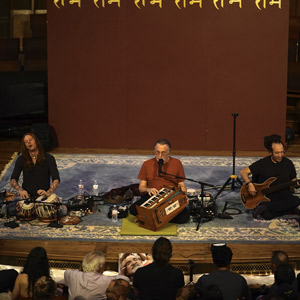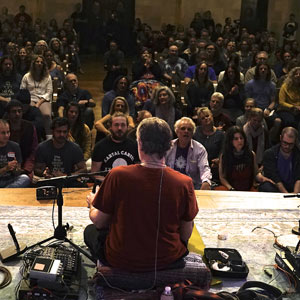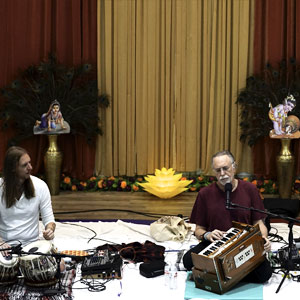Spirit: American Kirtankar, Krishna Das

(Left) Krishna Das in Atlanta as featured performer for ChantLanta 2019. (Photo: Perry Julien)
When one hears a chant like Aum Namoh Bhagvate Vasudevaya, it is not a Grammy award ceremony that comes to mind as the setting of such chanting; but that is precisely what Krishna Das has been able to do—take cherished age-old Indian kirtans to a global stage such as the Grammys. Nominated in 2012 for a Grammy for his album Live Ananda, Krishna Das also performed at the ceremonies in 2013.
Krishna Das was in Atlanta earlier this year performing at ChantLanta, a charity annual event that that celebrates the power of music and service. He spoke to Khabar about his journey into kirtans, about Westerners attracted to the bhakti traditions of India, why Americans connect with kirtans despite not being familiar with the words, stories and ethos behind them, and his insights on devotion and God.
If it is true that God works His magic through us mortals, He certainly chose the right vessel in Krishna Das to spread the love and joy of kirtans to the West. Krishna Das’s baritone voice, which is at once soothing, uplifting, and mesmerizing, is perfectly suited for this devotional singing. The purity and passion of his devotion is evident in the trance he routinely induces amongst his mostly American audiences at many of his live performances. One can barely imagine a better voice or a person of better sensibilities for kirtan chanting. His lilt, enunciation, and devotion make it appear as if Krishna Das comes from a long lineage of kirtankars—a remarkable feat, considering he had never heard a kirtan until his first visit to India in 1970.
Krishna Das, known as KD amongst his fans and followers, describes his live performances as a “call and response” event of collective devotion where his audience is encouraged to pick up the chant and sing with him. The love and grace that flows during these concerts is palpable. During these events, KD also shares his journey with his guru, and his sincere sharing brings one to the space of devotion. His unique style of blending age-old Indian devotional chants with contemporary Western music has earned him a growing fan base amongst new age spiritualists.
KD was born as Jeffrey Kagel in Long Island, NY, grew up to love music, and had aspirations of becoming a rock star. Meanwhile, life pushed him from one odd job to another. In 1968, while working as a school bus driver, he happened to come into contact with spiritual leader Ram Dass. Inspired by Ram Dass, in August 1970, Kagel sold everything he possessed, dropped his long-cherished dream of becoming a rock star, and set out for India on a spiritual quest. Ram Dass had sent him to his guru Neem Karoli Baba, near Nainital (Uttarakhand), where Kagel became Krishna Das, and found himself at home. While serving as priest in the temple he learnt to sing Hanuman Chalisa and chant the name divine. He was asked to return to the U.S. by his guru after two-and-half years.
KD first started chanting in 1994 at the Jivamukti Yoga Center, NYC. He listened to the call of his heart, to chant with others to face the dark corners of his heart. Since then, he has moved to concert halls and is now the bestselling Western chant artist of all times.
The following excerpt from his biography, appearing in www.allmusic.com, provides a good overview of KD’s prolific contribution to music.
In 1990, Das founded Triloka Records, a label that soon became a leading distributor of world music recordings from artists like Jai Uttal, Ali Akbar Khan, and jazz great Jackie McLean. His own debut album, One Track Heart, released in 1996, focused on updated Bhakti yoga chants. His 1998 follow-up, Pilgrim Heart, featured a guest appearance by Sting, the first of numerous pop artists with whom he would eventually collaborate. Over the coming decade, Das produced a prolific amount of music, from the Rick Rubin-produced Breath of the Heart and Door of Faith albums to 2007’s Gathering in the Light, a collaborative album with composer and overtone singer Baird Hersey and the choir Prana.
Excerpts from our interview with Krishna Das:

(Left) Krishna Das (KD) at his performance at ChantLanta, earlier this year. (Photo: Perry Julien)
Can you tell us when you were first exposed to kirtans, and how was that experience?
The first chanting I heard was in India, up in the mountains, in a town called Nainital. I had only been in India a few weeks. It was Navratri time. I was walking around the lake and I heard music coming from the ancient Naini Devi temple. I was immediately captured by the chanting. I couldn’t move. I was just standing outside the temple. A man who was going into the temple grabbed my arm and dragged me in with him.
That moment changed my life. I realized that I had to dive into chanting as deeply as I could. From that
moment, whenever or wherever I heard chanting, I
ran [towards it].
We hear kirtans from many different sources, from different people, but the impact is not the same. Is it the chanting or is it the intention or bhav of the singer that makes a kirtan more powerful?
Yes, a certain type of sincerity and humility is
required when you do spiritual practice. But also,
grace must be there. The blessings of a guru must be there. The blessings of God must be there; otherwise,
it is just music.
Are you touched the same way by other devotional genres such as Church choir or Sufi music? How,
for example, do kirtans differ in quality from choir singing?
As long as the intention of the chanting is to sing to God, it has the power to open one’s heart to the Lord. It doesn’t matter to me what religion the chanting belongs to, it simply moves me.
One can understand the deep feelings of devotion that kirtans can create amongst those who are familiar with Sanskrit, Hindi, and other Indian languages, and the stories and ethos behind the kirtans, such as the mischievous pranks of the baby Krishna. How and why do you think kirtans appeal to Westerners who may not be familiar with the language and the context of the bhajans and kirtans?
The Name and what is named are not different. God is not different from His Name. Repetition of the Name purifies the heart and calms the mind and allows the indwelling presence of the Lord, the Antarayami, to shine forth. The “story lines” are there to help capture our attention and move us toward God’s love. But God is love and love lives within us as our own true Being. Even if someone doesn’t know the storyline, they can still be moved by the bhava (“the intense sentiments conveyed by a performer”).
The following is of course a broad generalization, but typically the Western mind is a left-brain, logic-worshiping one. And yet, why do you think so many Westerners are attracted to the bhakti traditions of India?
Because the Indians have taken all the tech jobs!
Why is it that many times we don’t experience God even after repeating God’s name?
It is because we don’t see clearly. Because we human beings identify ourselves with our bodies, our minds, emotions, and thoughts. We live in deluded states, so we don’t see clearly. And because we don’t see clearly, we don’t experience the reality of the Name.
However, Shri Ramakrishna said that every repetition of the Name is a seed that is planted. At the proper time, when the causes and conditions are right, those seeds begin to grow. For instance, he says that the seeds of the repetition of the Name are blown by the wind and get stuck on the roof of an old house. Over time and seasons, the tiles on the roof crack, causing the seeds of the Name to take root. Then they keep on growing till they destroy the roof of the house, and then the walls of the house. Shri Ramakrishna says that house is who we think we are. So, through the repetition of the Name, the false sense of separateness is destroyed because we are not separate from God. We could never be separated from God, but because we think we are, we act like we are and we create more karmas by thinking and acting that we are separate. The seeds destroy the house. The house was put together, it was not natural, it was made—created. Anything that is created gets uncreated.
So, God is always here. Where else can He be? [The] repetition of the Name divine destroys delusion, illusion, and restores the order of things; [thus,] our true nature is let out of the cage. Even when the house (cage) is pakka (solidly built), even then the space inside the house is not different from the space outside the house. When those walls are down, nothing has really changed.
Even when we are locked behind those walls, there is no difference between the space in the house and outside the house. It feels different because we are thinking, acting, and behaving [as if] we are separate, because all day long we are thinking about me, me, me.
You notice Shri Ramakrishna doesn’t say you will feel like this or that, because it is not about you. Our experience is temporary, it is not important; it comes and it goes. Neither happiness nor unhappiness lasts, neither pain nor pleasure lasts. They are constantly changing. That is the nature of the delusion that we live in. He doesn’t even say you will feel joy or bliss. If you think that is the goal and you grab on to that, then you are lost, you are creating more separateness. So, do your practice, repeat the Name. You don’t even have to believe in it, because the Name itself has the power within it to remove the suffering of separateness. We don’t have to believe it, but believe it enough to do it. We don’t have to see if it is working or not working. All the gurus advise us to keep repeating the Name. Maharaj-ji (Neem Karoli Baba) says keep repeating it when you are happy, repeat it in sadness, repeat it in anger.
Your kirtan is called call-and-response. So, it
requires two parties. Many people nowadays live alone. What suggestion do you offer for an individual who lives a solitary life?
Keep breathing, it is required; keep eating, it is required; sleeping is usually required. We are all alone, anyway. It looks like there are other people around, but there are no other people. If you are alone in the house, you can run around naked, who cares? The idea is to do some practice. You can chant alone mentally, or aloud—it is called japa. It doesn’t have to be aloud, nobody has to be there, the idea is to repeat the Name. That is important, to do some practice. Because if we don’t set up an alarm, how will we ever wake up?

(Right) KD involves his audiences in his live performances, often creating a trancelike atmosphere of devotion. (Photo: Perry Julien)
What motivates us to do the practice?
What motivates us is that we recognize we are in pain and we want to relieve ourselves from the pain and suffering. Whatever it is, we find something to help us relieve pain.
Some people think that drinking is going to help them. Some people think that making more money is going to help them. Go ahead, make more money. You will be sitting alone in your room and you will not know what to do. How do we remove suffering? You have to do some practice, there is no other way around it. By practice, I use [the term] very loosely. [It includes] anything that helps us to recognize the situation in our life, in terms of how we treat human beings. Are we good human beings? Or are we selfish, self-centered, or uncaring about the feelings of others? This is what we have to look at. We have to become good human beings. That is how we get a diploma; this is why we have come to school.
Often, we sit for spiritual practice but our mind wanders. How do you stop wandering?
You add a little practice to come back from your dreamland. All we do is dream, dream, dream. How do we do that? When you wake up, do some spiritual
practice to come to the present moment. One has to turn towards one’s guru if we have one, or a deity; one has to cultivate being in their presence. We cultivate being in the presence of TV. We sit in front of the TV
for hours together and we don’t even realize it. To
sit for five minutes and feel the presence is difficult
to do unless we have some spiritual practice and
some connection. So, the purpose of the practice is to calm the mind, slow down the mind, to let go inch by inch. We are here, just be here. Repeat the Name. You notice that your attention has gone… bring back the attention gently. What is it that makes you aware that you have wandered? Recognize that which is making you aware that you have wandered.
Does that mean we have to be grateful for the recognition of wandering, rather than beating ourselves up that we are not able to pay attention?
You don’t [have to] come from the space of unworthiness, shame, and “not good enough.” See your thoughts and let them go and bring back the attention to the Name. When people come to kirtan—they sing, then they wander, then again, they sing. Who makes them recognize that they have wandered? They didn’t do it because they were wandering, and I didn’t do
it [either]. Then who does that? Isn’t that grace? Yes,
be grateful that you recognized your wandering.
You talk about bringing back the attention—so is it the training of attention to the present moment? Some use work, seva, to develop awareness to the present moment.
It depends. Once Maharaj-ji asked Mr. Tewari who is a Brahmin, my Indian father, and a friend, “What does Krishna teach in Bhagavad Gita?” “Nishkam karma (selfless action),” replied Mr. Tewari even though he knew he was [being] set up. Maharaj-ji said, “Oh you miserable Brahmin, misleading the people, only God does nishkam karma.” This is a very deep statement. It is not a throwaway. Action that is not motivated by personal agenda, OK. Where is the God that does that? Up in the sky? It is within us as our true nature when we act without personal agenda, when we act out of compassion, out of kindness—not in terms of feeling good. A lot of people say, I’m doing nishkam seva, I am cleaning the temple. Bullshit, this is not seva, this is motivated action to prop one’s ego. When one is in harmony with that love, then everything one does is for the sake of others. Not for one’s own enjoyment, not for the sake of propping oneself from ego to say, “I am doing seva today.” Seva means serving God within people, [it’s] not about feeling good. When we work, aren’t we getting paid? Isn’t there a personal agenda?

(Left) Images of Bala Krishna are in the background. KD has been able to bring the age-old devotional traditions of India into the lives of contemporary Americans who are spiritual seekers. (Photo: Perry Julien)
Some say they don’t believe in God?
God … who knows? But what we have in front of
us is our body, minds, emotions, and thoughts and
[the] desire to be free of suffering. They might not believe in God but they do believe in their own pain.
When they are in pain, they will chant. One doesn’t need to believe in anything but one needs to know
that they are suffering. Which everybody knows—that there is suffering. It is very clear to everyone that they are unhappy. When someone stamps on your toes
you know you are in pain, you don’t need to believe in
anything. The realization that you are in pain will
motivate you to practice to relieve yourself of suffering. Whether one believes in God or not, the Name alone can relieve one from suffering.
Now that you are the “rock star” of kirtans, how has that changed your life?
I don’t know if I can say it changed my life … but it has become my life. I am so grateful that I can chant with people. There is nothing I could be doing that would be better for me, and also good for others. It
just feels that my life has been “ripened” by my guru’s grace … and now I am free to chant His Name.
Enjoyed reading Khabar magazine? Subscribe to Khabar and get a full digital copy of this Indian-American community magazine.
blog comments powered by Disqus












